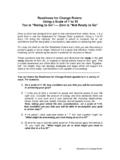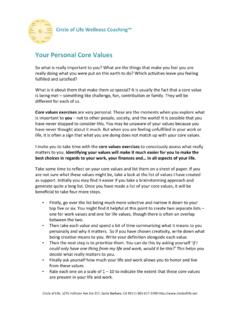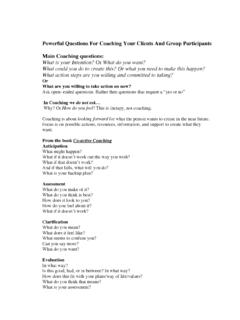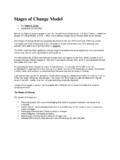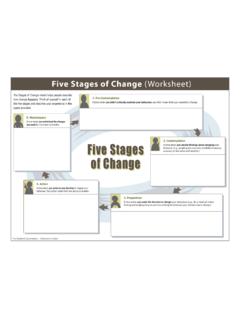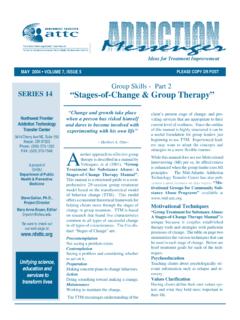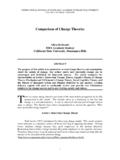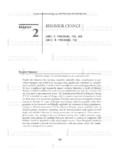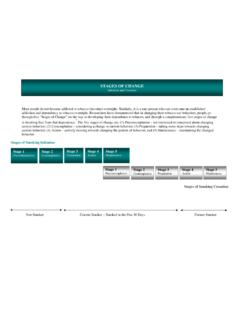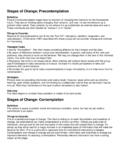Transcription of Behavioral Change - Stages of Change
1 Behavioral Change Stages of Change 11 Behavioral Change - Stages of Change Research has shown that self- Change is a staged process. We move from not thinking about changing a behavior, to thinking about it, to planning to Change , and to testing out ways to do it before we actually start. Clients can be in different Stages of readiness for different things. YOUE GOAL IS TO EMPOWER CLIENTS TO RECOGNIZE AND KNOW THAT THEY ARE IN CHARGE. ONLY THEY KNOW WHEN THEY ARE READY TO Change . DECISIONAL BALANCE - the individual weighs the pros and cons of Change PROS - REASONS TO MAKE THE Change CONS - REASONS WHY IT IS SO HARD TO MAKE THE Change SELF EFFICACY- situation-specific confidence people have that they can succeed IF YOU BELIEVE YOU CAN, YOU PROBABLY WILL IF YOU DO NOT BELIEVE YOU CAN, YOU WILL PROBABLY FAIL Allow clients to come up with their own ideas so they OWN the process Processes of Change COGNITIVE PROCESSES / THINKING AND FEELING (used throughout for all Stages ) 1.
2 Getting Information: Finding out about all the benefits ( , medical and lifestyle) of a new behavior. 2. Being Moved Emotionally: Taking to heart the effects of a behavior and using them to ignite the drive to Change 3. Considering How Your Behavior Affects Others: For example, thinking through what your children may be learning from watching your behavior. 4. Self-Image: Connecting the dots and seeking congruence among one s vision, values, and behaviors in order to enhance integrity. 5. Social Norms: Connecting and talking with like-minded people who are all working on the same behavior ( , a support or special-interest group) NOT JUST FAMILY AND FRIENDS SUPPORTING THE EFFORT. Behavioral PROCESSES (used from preparation on) 1. Making a Commitment: For example, writing down exactly what new behavior will be and when, coaching contract to create accountability.
3 2. Using Cues: For example, designing environmental reminders to do what is planned. Behavioral Change Stages of Change 12 3. Using Substitution: Replacing an old health-risky behavior with a new health-promoting behavior, substituting carrot sticks or a straw for a cigarette. Let the client think of own substitution 4. Social Support: family and friends to help with behavior Change by specifically asking each of them to consider the particular thing you would like them to do for you. This requires clients to think carefully about what they would like someone to do and then to ask the person on their support team to do it. Beware of the advice of a saboteur; mastery of Change is threatening to someone else . 5. Rewards: Setting up ways to be rewarded or rewarding yourself for completing your weekly action goals 1.
4 Precontemplation : I won t or I can t Client needs sincere non-judgmental empathy from the coach. Use reflections to demonstrate that you understand and are not going to try to force them to Change at this. I m here for when you are ready to _____. 2. Contemplation: I may (ambivalence) Client is thinking about changing an unhealthy behavior (usually within 6 months). Client is more aware of the benefits of Change /less satisfied with their present health. Explore best experiences with past changes. Help clients focus on values and vision. Share important information about benefits when appropriate. Connect to strengths. Increase awareness of compelling reasons to Change . Encourage clients to connect with people who have successfully made the Change are key, motivational strategies.
5 James Prochaska s Transtheoretical Model of Change - (TTM) PRECONTEMPLATION - I WON T OR I CAN T CONTEMPLATION - THINKING ABOUT Change - I MAY PREPARATION - PREPARING FOR ACTION I WILL ACTION - TAKING ACTION I AM MAINTAINANCE MAINTAINING A GOOD BEHAVIOR I STILL AM Behavioral Change Stages of Change 13 Remember that, at this stage , the small goals will involve reading, thinking, talking, listening, discovering, and deciding not doing a behavior) 3. Preparation: I will Client should be able to verbalize motivators, envision obstacles, and provide solutions/ strategies. Coach assists clients to develop concrete plans for Change . Encourage clients to write down a formal statement of what they are committing themselves to do, containing specific details of what, when, and how. Help clients explore the difficulties of doing the new behaviors and encourage them to identify ways to work these out.
6 Do not add to the resistance by telling clients what to do. Discuss situations clients think could be problematic when they actually start the behavior, and have them develop strategies to cope before the situation arises. 4. Action: I am (doing the behavior that produces desired results) Most coaching takes place with people who are in this stage . Explore challenging situations and encourage client to learn from it. Develop new relationships with people who share their interests and Behavioral goals. Without modeling and support, lapses can easily trigger a downward spiral. Help clients to connect their new behaviors with their strengths, values, and preferred environments (including social networks). The more modes of support they can identify, the better. Since there is a high risk of lapse and relapse back to preparation at this stage , techniques to manage challenging situations are important.
7 Note that there is a distinction between lapse versus relapse. A lapse is a single slip in a desired behavior that may or may not lead to a relapse 5. Maintenance: I still am It takes 21 days to develop a new habit, and 21 months to develop a new lifestyle. Clients are now confident that they can maintain the new behavior, and would rate their confidence to maintain the new behavior at a level of 8 or 9 out of 10. In this stage , their self-efficacy is both high and self-reinforcing. Possible Obstacles: Boredom Short term motivation that is no longer effective Strategies: Encourage clients to be a role model for others. Encourage clients to develop long term vision Keep clients connected to their strengths, values, resources, vision, goals, and motivators. Derived from Transtheoretical Model, developed by James O.
8 Prochaska.
